Photo


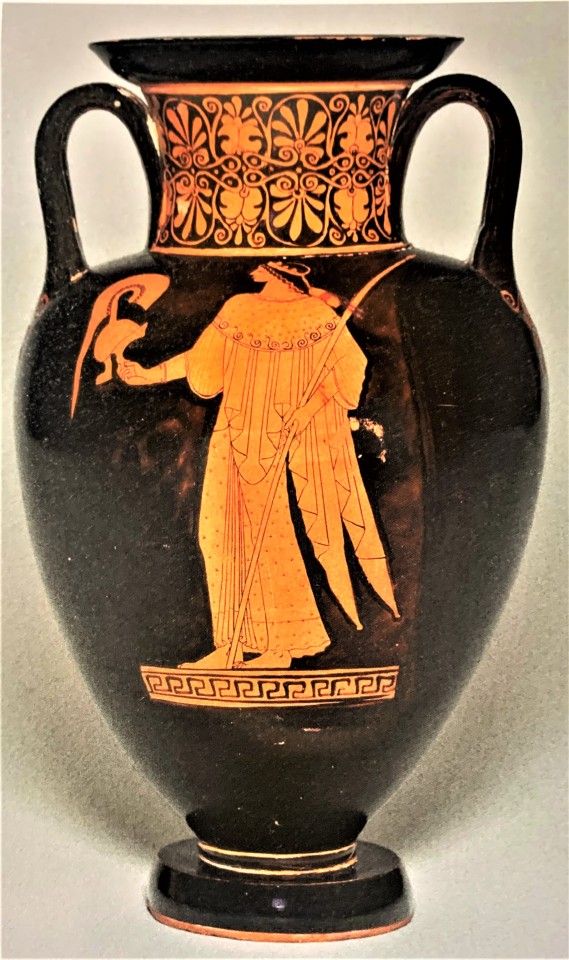
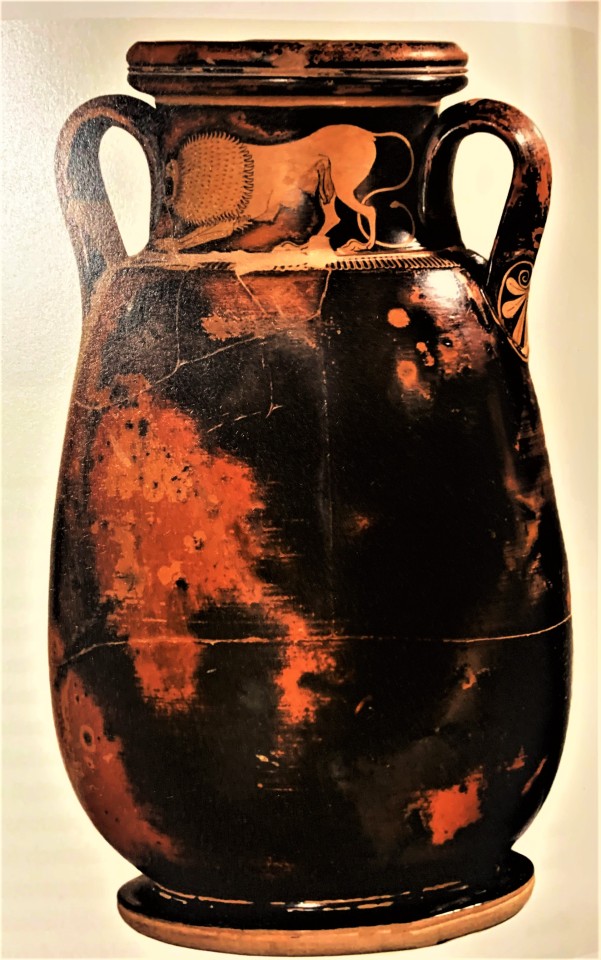
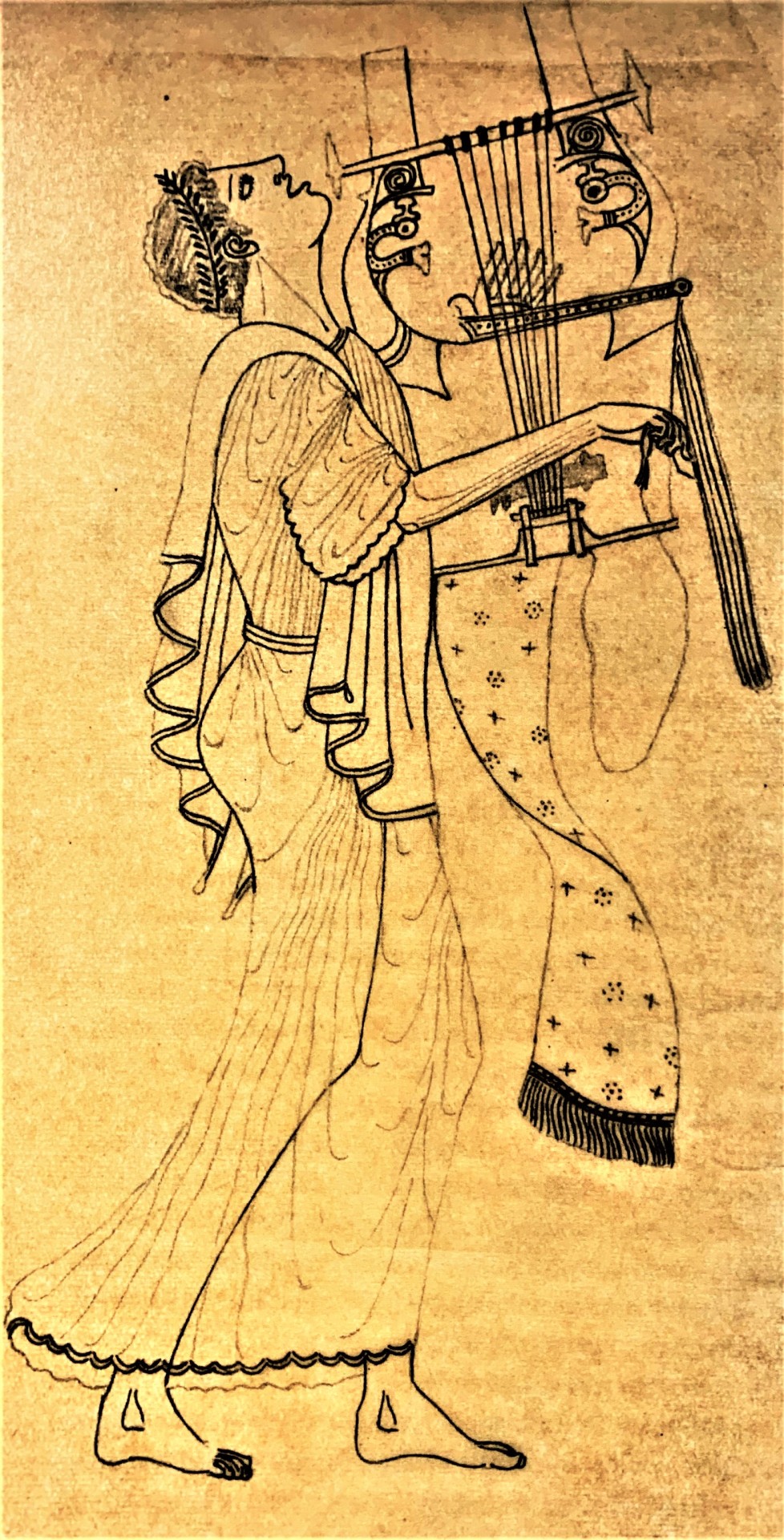
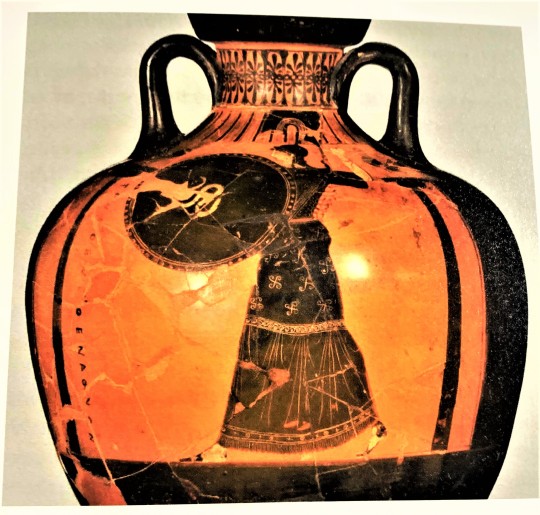
The Berlin Painter
Of all the vase painters of ancient Athens, there is one who continues to captivate all those who witness their works, not only for their splendor and skill, but also for their mystery. The identity of the artist dubbed the Berlin Painter is something we may never know. Although over 200 pieces have been identified as being painted by this individual, none of them hold the name of the artist. This is highly unusual, since by the time of the early 5th century BCE, the period when the Berlin Painter’s vases are dated, both master potters and painters would commonly place their names on their favored works.
The Berlin Painter and His World: Athenian Vase-Painting in the Early Fifth Century B.C. edited by J. Michael Padgett, Curator of Ancient Art at the Princeton University Art Museum, and published by the Museum in 2017 on the occasion of exhibitions of the same name at the Princeton University Art Museum and the Toledo Museum of Art, is the definitive work on this ancient Greek artist, and includes an updated catalogue raisonné, With contributions by several leading scholars, the work seeks to rebuild the ancient city of Athens though the ceramic remains by artists such as the Berlin Painter.
The highly decorated pottery of ancient Athens allows us to see the wide spread of influences this culture had on both the Mediterranean world and Central Europe. While beloved by those in the Hellenic world, others imported the pottery, as luxury items and elaborate symbols of wealth. The Etruscans from the Italian peninsula regularly furnished their tombs with kraters, wine mixing vessels, and the Celts of modern-day France and Germany would regularly feast using the Athenian pottery. Though lacking the fast-traveling methods available today, the broad distance where Athenian pottery can be found demonstrates that the cultures of the Mediterranean and Europe were closely connected.
View more Decorative Sunday posts.
View more of my Classics posts.
View more posts on Ancient Greece.
– LauraJean, Special Collections Classics Intern.
#Decorative Sunday#decorative arts#decorative plates#The Berlin Painter#Athens#ancient Athens#Ancient Greece#classical greece#vases#vase painting#5th century BCE#The Berlin Painter and His World#J. Michael Padgett#Princeton University Art Museum#Greek art#LauraJean
38 notes
·
View notes
Text
Rewind the Tape —Episode 1
Art of the episode
During our rewatch, we took note of the art shown and mentioned in the pilot, and we wanted to share. Did we miss any? Do you have any thoughts about how these references could be interpreted? How do you think Armand and Louis go about picking the art for their penthouse in Dubai?

The Fall of the Rebel Angels
Peter Bruegel the Elder, 1562
This painting is featured in the Interview with the Vampire book, and it was important enough to be included in the draft pilot script!

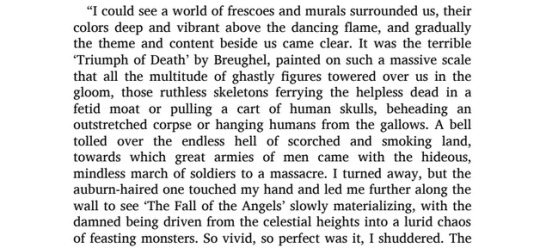
Bruegel the Elder was among the most significant Dutch and Flemish Renaissance artists. He was a painter and print-maker, known for his landscapes and peasant scenes.

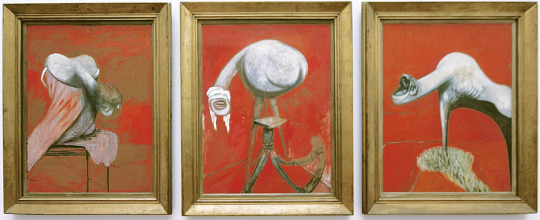
Three Studies for Figures at the Base of a Crucifixion
Francis Bacon, 1944
Bacon was an Irish figurative painter, known for his raw, unsettling imagery and a number of triptychs and diptychs among his work. At a time when being gay was a criminal offense, Bacon was open about his sexuality, and was cast out by his family at 16 for this reason. He destroyed many of his early works, but about 590 still survive. The Tate, where these paintings are displayed, says this about the work: "Francis Bacon titled this work after the figures often featured in Christian paintings witnessing the death of Jesus. But he said the creatures represented the avenging Furies from Greek mythology. The Furies punish those who go against the natural order. In Aeschylus’s tragedy The Eumenides, for example, they pursue a man who has murdered his mother. Bacon first exhibited this painting in April 1945, towards the end of the Second World War. For some, it reflects the horror of the war and the Holocaust in a world lacking guiding principles."

On the Hunt or Captain Percy Williams On A Favorite Irish Hunter and Calling the Hounds Out of Cover
Samuel Sidney, 1881 [Identified by @vfevermillion.] and Heywood Hardy, 1906 [Identified by @destinationdartboard.]
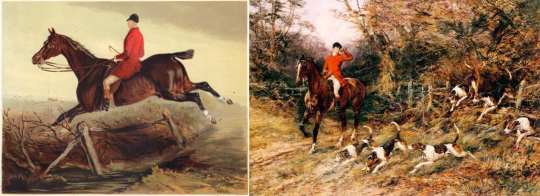
Sidney was an English writer, and his prints usually accompanied his publications about hunting, agriculture, and about settling Australia during the colonial period. Hardy, also British, was a painter, in particular an animal painter. There's also a taxidermy deer, ram, and piebald deer on the wall.
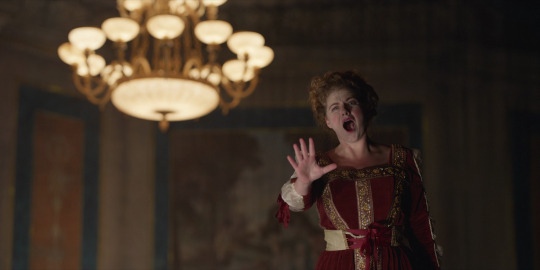
Iolanta
Pyotr Tchaikovsky, 1892
The opera Louis and Lestat go to was composed by Tchaikovsky, another gay artist. The play tells a story "in which love prevails, light shines for all, lies are no longer necessary and no one must fear punishment," as put by Susanne Stähr for the Berliner Philharmoniker.

Strawberries and Cream
Raphaelle Peale, 1816 [Identified by @diasdelfuego.]
Peale is considered to have been the first professional American painter of still-life.

Outfits inspired by J.C. Leyendecker
Leyendecker was one of the most prominent and commercially successful freelance artists in the U.S. He studied in France, and was a pioneer of the Art Deco illustration. Leyendecker's model, Charles Beach, was also his lover of five decades. You can read costume designer Carol Cutshall's thoughts on these outfits on her Instagram.

The Artist's Sister, Melanie
Egon Schiele, 1908 [Identified by @dwreader.]
Schiele was an Austrian expressionist painter and protege of Gustav Klimt. Many of his portraits (self portraits and of others) were described as grotesque and disturbing.
A Stag at Sharkey's
George Wesley Bellows, 1909 [Identified by @vfevermillion.]
Bellows was an American realist painter, known for his bold depictions of urban life in New York City.

Mildred-O Hat
Robert Henri, undated (likely 1890s) [Identified by @nicodelenfent, here.]
Henri was an American painter who studied in Paris, where he learned from the Impressionists and determined to lead an even more dramatic revolt against American academic art.
Starry night
Edvard Munch, 1893 [Identified by @vfevermillion.]
Munch was a Norwegian painter, one of the best known figures of late 19th-century Symbolism and a great influence in German Expressionism in the early 20th century. His work dealt with psychological themes, and he personally struggled with mental illness.
If you spot or put a name to any other references, let us know if you'd like us to add them with credit to the post!
Starting tonight, we will be rewatching and discussing Episode 2, ...After the Phantoms of Your Former Self. We hope to see you there!
And, if you're just getting caught up, learn all about our group rewatch here ►
#louis de pointe du lac#daniel molloy#lestat de lioncourt#vampterview#interview with the vampire#iwtv#amc interview with the vampire#interview with the vampire amc#amc iwtv#iwtv amc#IWTVfanevents#rewind the tape#in throes of increasing wonder#analysis and meta#art of the episode
95 notes
·
View notes
Text




Adolph Dehn, The Great God Pan (1940)
Over at the Philadelphia Museum of Art site you can see the multiple layers of this screen print by Adolph Dehn of some nuns painting the god Pan. Pretty great.
This lithograph is also great:

I'd never heard of Dehn's work before — he was a friend of the great Wanda Gág, whose book Millions of Cats I read to my kids “millions and billions and trillions” of times.
He did a lot of nun pieces:



Here's a biography of Dehn from The Smithsonian:
Dehn's satirical prints of European and New York scenes were the product of an unconventional Minnesota upbringing and an iconoclastic eye. The son of a feminist, socialist mother and an atheist, anarchist father, he was not destined for a quiet life. He studied at the Minneapolis Art Institute and the Art Students League in New York, after which he was imprisoned as a conscientious objector during World War I. On his release Dehn took odd jobs and made his way to Europe, where his work as a magazine illustrator supported him and his Russian immigrant wife in their travels. While in Europe Dehn was a critical observer of the social scene, especially in Vienna and Berlin, and a light-hearted painter of park scenes and landscapes. In 1930, after his return from Europe, his work, on both European and New York subjects, was shown at the Weyhe Gallery in New York City. The critical response was good, but sales were only moderate. In the mid-1930s, Dehn began to paint watercolor landscapes, which proved immensely popular. As a result, new commercial opportunities opened, including travels through the United States, Mexico, and Venezuela. His fame led to offers to teach and then to work for the Navy during World War II. Throughout the forties, fifties, and sixties, Dehn and his wife traveled around the world, doing commercial work and lithography. His work became less satirical and more fanciful, and he experimented with new graphic techniques. He died of a heart attack in 1968 while planning new trips, beginning a book, and organizing a retrospective.
See more of his (non-nun) work here.
21 notes
·
View notes
Text

The poet Walter Rheiner whose novella "Cocaine",illustrated by his friend Conrad Felixmüller,took a fatal overdose in his apartment in Berlin in June 1925.World War l was over and new generation of painters,who had survived the trenches,turned away from utopian ideals. Artists such as Otto Dix,Georg Grosz and Christian Schad revelled in capturing life realistically and honestly.Conrad Felixmüller became part of the new movement New Objectivity a few weeks after Rheiner’s death.And painted an obituary to his friend,the poet Rheiner.Berlin as a labyrinth of angular planes.The dying writer,who holds the fatal syringe between his fingers.The luminous colours add to the dreamlike quality of the scene.
"Death of Poet Walter Rheiner",c.1925
Conrad Felixmüller(Germany,1897-1977)
Oil on canvas
11 notes
·
View notes
Text

The Secret Salon
The Late 19th Century: A Time of Change in Art and Culture
The late 19th century was marked by profound cultural, technological, and societal changes. While movements like Historicism, Academicism, and Symbolism dominated the art world, a hidden subculture of LGBT artists also emerged, meeting in private salons and circles to explore their identities.
Historicism and Academicism Historicism focused on reviving past styles such as Gothic and Renaissance. In architecture and painting, historical themes were used to create dramatic or heroic effects. A prominent figure was the Austrian painter Hans Makart, known for his opulent historical paintings.
At the same time, Academicism flourished, supported by the art academies. This movement valued technical perfection and the depiction of idealized bodies. Artists like Jean-Léon Gérôme and William-Adolphe Bouguereau created works influenced by mythological and erotic themes. Sensuality played a central role, particularly in depictions of male and female beauty.
Secret LGBT Gatherings and Artistic Salons While these artistic movements were celebrated publicly, private salons emerged where LGBT artists and intellectuals met. In cities like Paris, Berlin, and Vienna, these gatherings took place behind closed doors, as homosexuality was socially taboo. Such salons provided a safe space for intimate and sensual encounters as well as the exchange of ideas.
Oscar Wilde and Magnus Hirschfeld were well-known figures who used these spaces to freely explore their sexuality and art. These gatherings often became moments of inspiration, celebrating both artistic and social freedom.
Symbolism: Exploring the Mystical and the Sensual Symbolism emerged as a counter-movement to Academicism, seeking new ways to explore the deeper, spiritual aspects of human experience. Artists like Gustave Moreau and Arnold Böcklin focused on allegorical and mystical themes, often incorporating erotic undertones.
Gustav Klimt combined both sensual and mystical elements in works like "The Kiss," creating an artistic fusion of sexuality and transcendence.
Conclusion The late 19th century was a time of change and contradictions: while the art world was dominated by traditional movements like Historicism and Academicism, hidden LGBT artist circles explored new forms of sensuality and artistic expression through intimate gatherings and salons. This era marked a transition into modernity and laid the groundwork for the radical artistic innovations of the 20th century.
Text supported by GPT-4o Image generated with SD1.5. Overworked with inpainting (SD1.5/SDXL) and composing.
13 notes
·
View notes
Text
My next post in support of Ukraine is:
Next site, is another Ukrainian. Oleksandr Porfyrovych Archipenko (Олександр Порфирович Архипенко), an avant-garde artist, sculptor, and graphic artist. He was born in Kyiv in 1887. He studied at the Kyiv Art School & the Serhiy Svetoslavsky (named after a Ukrainian landscape painter). He moved to moscow for a short while but then moved to Paris in 1908. He became a resident of La Ruche, an artist colony in Paris, which included a few other Ukrainian artists. He moved again in 1914 to Nice. In 1920, he opened his own art school in Berlin. Then, in 1923, he emigrated to the United States and became a US citizen in 1929. In 1933, he participated in the Century of Progress World's Fair in Chicago for the Ukrainian pavilion. He actually "contributed the most to the success of the Ukrainian pavilion." In 1962, he was elected to the American Academy of Arts And Letters, an organization dedicated to "foster, assist, and sustain excellence in American literature, music, and art." He passed away in 1964 in New York, US.
#StandWithUkraine
#СлаваУкраїні 🇺🇦🌻


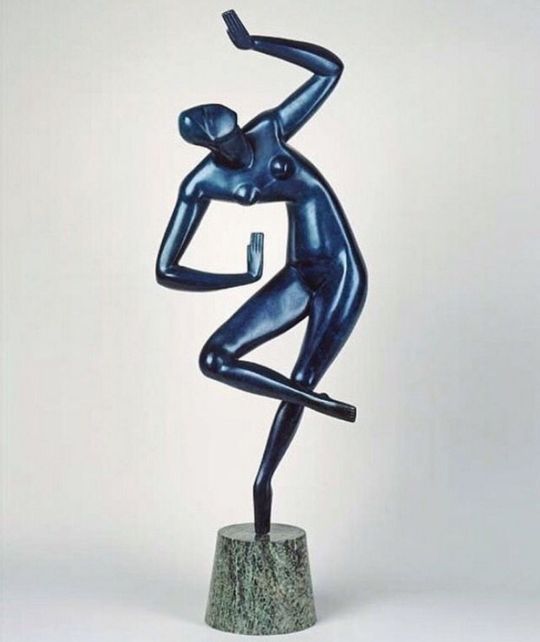
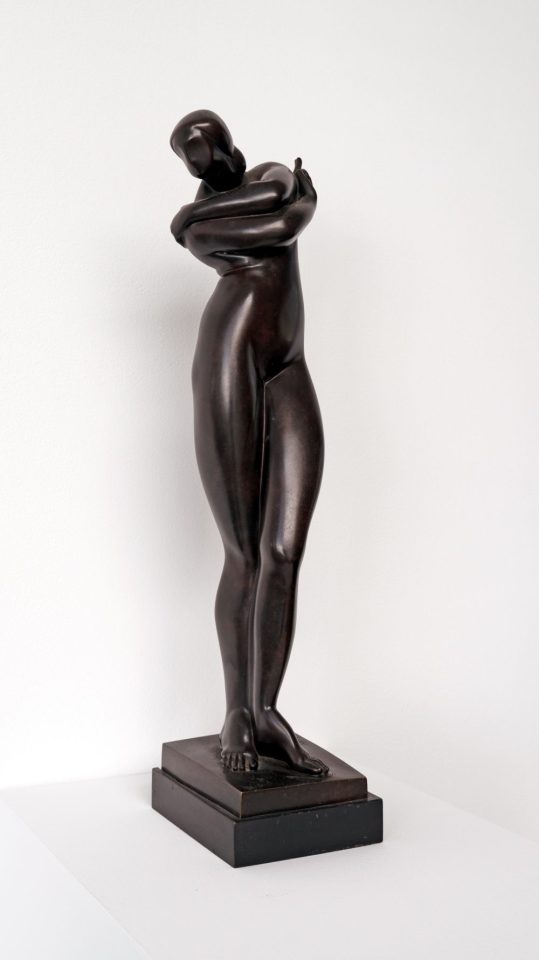
11 notes
·
View notes
Text


Carl Buchheister (1890-1964) both before and after WWII was one of Germany's prime abstract artists. Although his father had other intentions for his son Buchheister after the First World War pursued a career as painter in his hometown Hannover, a city that in the 1920s was home to a number of remarkable artists, among them not only Kurt Schwitters but also Friedrich Vordemberge-Gildewart and Rudolf Jahns with whom he formed the group "die abstrakten hannover". From 1926 on he also was a regular at Herwarth Walden's gallery "Der Sturm" in Berlin which further advanced his career and recognition, probably also leading to his membership in the Paris group "abstraction création". At the time Buchheister equally followed the rigid geometry of constructivism and a more organic, sensual abstraction.
Like most avant-garde art his works were labeled "degenerate art" during the Third Reich and he returned to painting figuratively, something he also did during his war service between 1939 and 1945. After the war Buchheister first retreated into his studio and between 1946 and 1948 redefined his style towards an informalism infused with impressions of nature and a a free reign of color.
The present two volume catalogue raisonné, edited by Willi Kemp and published by Verlag der Buchhandlung Walther König, offers a complete account of Buchheister’s abstract work: while the first volume contains various texts by art historians and friends/contemporaries like Otto Piene, Karl Otto Götz as well as a concise biography by the editor, the second volume, a tome of more than 700 pages, is entirely dedicated to Buchheister's paintings, drawings, prints etc. Chronologically split into the time before 1934 and after 1945, thus leaving out the artist's figurative work during the Third Reich, the catalogue enables the reader to track his development from early constructivism to the late and significantly less rigid informalist works. What becomes obvious is the fact that Buchheister never quite was a rigid and dogmatic constructivist but a deeply sensual artist whose art gradually opened up to the sensual impressions his late works are characterized by.
#catalogue raisonne#carl buchheister#abstract art#art book#art history#constructivism#art informel#book
11 notes
·
View notes
Photo
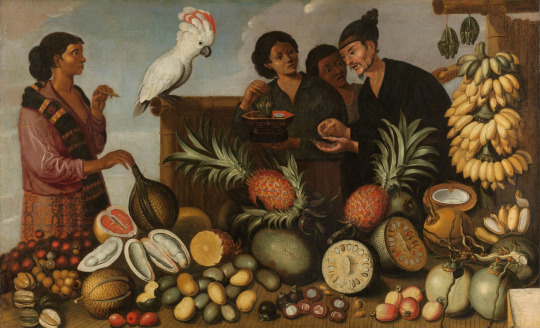
A Market Stall in Batavia, Andries Beeckman (attributed to), Albert Eckhout (rejected attribution), c. 1640 - c. 1666
The Dutch and Malay inscriptions on the piece of paper in the lower right corner identify this as a Dutch painting of subjects studied on the spot. Most of the fruit varieties are found only in Indonesia, the former Dutch East Indies, and were not exported to Europe at the time. The combination of figures from different countries suggests that the setting is most probably the very cosmopolitan Batavia, modern-day Jakarta.8 A Chinese merchant, recognizable as such from his distinctive goatee, moustache and remarkably long fingernails, is counting coins in a fruit stall set off with bamboo partitions. Standing on the left is a woman wearing a typically Javanese sarong and kebaya and holding a small cigar in one hand while placing a durian upright with the other. A second Javanese woman in the middle is lifting a small bundle of leaf wrappers out of a small Japanese lacquered casket, probably betel leaves. A boy behind her is picking a banana from the bunch hanging on the right. A striking salmon-crested cockatoo (Cacatua moluccensis) is perched on the bamboo screen at the back.
Andries Beeckman went to great lengths to depict the huge diversity of tropical fruit as faithfully as possible, but he was clearly not a professional still-life painter. The different varieties are easily distinguished, but their textures are not convincing. Laid out on the table – some with numbers matching the list on the piece of paper (the latter are given between brackets below) – are, on the far left, from top to bottom, rambutans (Nephelium lappaceum, no. 1), langsats (Lansium domesticum, no. 3) and starfruit (Averrhoa carambola, no. 2). Beside them are a partly cut pomelo (Citrus maxima, no. 4) and durians, one of them sliced (Durio, no. 5). The three small pieces of red fruit at bottom left are water or Malay apples (Syzygium aqueum or Syzygium malaccense, no. 6) or Java apples (Syzygium samarangense), and lying to their right are mangoes (Mangifera indica, no. 7) and pineapples (Ananas comosus, no. 8). Below the two pineapples in the centre are jackfruit, one halved (Artocarpus Heteropyllus, no. 9) and several small mangosteens, some opened (Garcinia mangostana, no. 10). On the right are bananas (no. 11), five coconuts and a halved one (Cocos nucifera), and at the very front cashew apples (Anacardium occidentale). The fruit cut in two in the Japanese casket is probably a sort of lime called a Calamondin orange (Citrofortunella microcarpa).
The Rijksmuseum painting is a reduced version of a canvas from an anonymous series of scenes of foreign peoples and produce that decorated the walls of Schloss Pretzsch an der Elbe in Saxony until 1828 (fig. a).9 In the nineteenth century they were removed, first to Berlin and then to Schloss Schwedt an der Oder in Brandenburg.10 They were seen there in the 1930s by Thomsen, who rather hesitantly attributed them to Albert Eckhout and dated them around the middle of the seventeenth century.11 Schwedt was completely destroyed in the closing days of the Second World War, and all that is left of the works of art are pre-war black-and-white photographs making it clear that the attribution to Eckhout is untenable.12
The connection with the canvas from Schloss Pretzsch also led to this Market Stall in Batavia being wrongly attributed to Eckhout or his circle in the past.13 It is woodenly executed, compositionally clumsy, and is not of the kind of Brazilian subject for which Eckhout is known. Minor differences between the two paintings show that they were not copied after each other but seem to share the same or a similar source. The way in which the fruit and cockatoo are depicted displays a clear resemblance to the only known still life by Andries Beeckman (fig. b), and, interestingly, one of the scenes from the series in Pretzsch castle was definitely based on watercolours by him,14 so the present canvas could also be by Beeckman or someone from his circle.
Very little is known about the picture’s provenance, although there are a few early records of an Indonesian fruit market, and since A Market Stall in Batavia is the only surviving work of that nature there is a great temptation to associate it with those early sources. There is, however, nothing that can be said for certain. Around 1660 Jan Vos wrote an ode about paintings in the collection of Joan Huydecooper, among them an ‘East Indies fruit market’: ‘Who has driven me from the north to the east? / I find myself in the market of the East Indies coast. / Here nature displays her fruit as food for life. / The sight makes my mouth desire the beautiful harvest, / Thus is my stomach now sorely overburdened. / Greedy eyes are not soon satiated’.15 It may well be that the poet was referring to the Rijksmuseum canvas.16 There is a second mention of an ‘East Indies fruit market’ a little later in the collection of burgomaster Mattheus van den Broucke of Dordrecht.17 It is far from obvious that it refers to this Market Stall in Batavia. His picture was one of a series of which the others were described as ‘One ditto, with East Indies animals and fruit’, ‘One ditto, being East Indies lodgings, ‘One ditto’, ‘Three ditto, East Indies women’ and ‘A Moorish woman’.18 It is very possible that the Rijksmuseum painting was also part of a larger ensemble of that kind.
Erlend de Groot, 2022
#hanfu#indonesia#art#sarong#Andries Beeckman#kebaya#懒收巾#jingguan#headwear#dutch painting#A Market Stall in Batavia
76 notes
·
View notes
Text

Ludwig L. Ehrenberger (1878–1950), At 5 in the morning!, Berlin, 1922, watercolour.
Ludwig (Lutz) Ehrenberger, pseudonym Henry Sebastian and Böckenyi (* 14 March 1878 in Graz; † 30 November 1950 in Saalfelden) was an Austrian poster artist, painter as well as advertising and illustration artist. During the First World War he worked as a war painter. In Munich he began working for the illustrated magazine Der Komet, and from 1913 to 1929 he was editor and political cartoonist for the satirical magazine Lustige Blätter in Berlin. He had studios in Saalfelden, Munich and, until 1935, in Paris, where he published his drawings under the pseudonym Henry Sebastian
3 notes
·
View notes
Text

"The sad truth is that musicals are the only public art form reviewed mostly by ignoramuses. Books are reviewed by writers, the visual arts by disappointed, if knowledgeable, painters and art students, concert music by composers and would-be composers. Plays, at least in this country, are reviewed by people who don't know de Montherlant from de Ghelderode and couldn't care less, whose knowledge is comprised of what they read in Variety and gossip columns, and who know nothing, of course, about music. Musicals continue to be the only art form, popular or otherwise, that is publicly criticized by illiterates."
Stephen Sondheim has stated that his original ambition was to become a mathematician and that he became a composer largely by chance. A big influence was the fact that famed lyricist Oscar Hammerstein (of Rodgers & Hammerstein) was a neighbor of his when Sondheim was a boy. When he wrote a musical for a school production, he showed it to Hammerstein who told him it was the worst musical he had ever read. However, Hammerstein also told him that nonetheless it showed a lot of latent talent and proceeded to tell him everything that was wrong with it and how to fix it, for which Sondheim was always grateful.
"Oscar Hammerstein had urged me to write from my own sensibility, but at that time I had no sensibility, no take on the world. My voice snuck up on me. I started to develop an attitude in 'Saturday Night,' a laconic lyrical style in 'Gypsy' and a structurally experimental musical one in 'Anyone Can Whistle.' They all came together in full-throated fruition in 'Company.' 'Oh,' I thought at the end of the opening number, 'that's who I am.' From then on I could afford to try anything, because I knew I had a home base that was mine alone and that would inform everything I would write, good and bad."
"Just before he died, he gave me a picture of himself and I asked him to inscribe it, which is sort of odd because he was a surrogate father to me, it's like asking your father to inscribe a picture. And he thought for a minute, and he was clearly a little embarrassed. And then he got a smile on his face, like the cat had just eaten the cream. And he wrote something. And when he left the room, I looked at it. And it said 'For Stevey, my friend and teacher.' That's a measure of Oscar. He wrote a lyric, as a matter of fact, in 'The King and I' -'By your pupils, you are taught.' He was a remarkable fellow."
A musical based on the memoirs of Gypsy Rose Lee was a project of producer David Merrick and actress Ethel Merman. Merrick had read a chapter of Lee's memoirs in Harper's Magazine and approached Lee to obtain the rights. Jerome Robbins was interested, and wanted Leland Hayward as co-producer; Merman also wanted Hayward to produce her next show. Merrick and Hayward approached Arthur Laurents to write the book. As he relates, Laurents initially was not interested until he saw that the story was one of parents living their children's lives. Composers Irving Berlin and Cole Porter declined the project. Finally, Robbins asked Sondheim, who agreed to do it (Sondheim had worked with Robbins and Laurents on the musical "West Side Story"). However, Merman did not want an "unknown" composer, and wanted Jule Styne to write the music. Although Sondheim initially refused to write only the lyrics, he was persuaded by Hammerstein to accept the job.
"Gypsy" opened on Broadway in May of 1959, and is frequently considered one of the crowning achievements of the mid-twentieth century's conventional musical theatre art form, often called the book musical. "Gypsy" has been referred to as the greatest American musical by numerous critics and writers, among them Ben Brantley ("what may be the greatest of all American musicals...") and Frank Rich. The role of Mama Rose was played by Rosalind Russell in the 1962 film version; the closest Merman got to recreating her stage success on the big screen was in the hospital scene in "Airplane!" (1980) (she starts belting out "Everything's Coming Up Roses" and has to be sedated).
Sondheim on the song 'Everything's Coming Up Roses' from "Gypsy": "The difficulty was to find a way to say 'Things are going to be better than ever' without being flatly colloquial on the one hand or fancifully imagistic on the other. I was proud of the solution, and especially so when I picked up the New York Times one morning in 1968 and read the first sentence in the leading editorial: 'Everything is not coming up roses in Vietnam.' I had passed a phrase into the English language." (IMDb/Wikipedia)
Happy Birthday, Stephen Sondheim!
Cinema Shorthand Society
#Cinema Shorthand Society#Stephen Sondheim#songwriters#musicals#the theatre#song lyrics#history#Rogers and Hammerstein
4 notes
·
View notes
Text

Edvard Munch was a Norwegian painter. His best known work, The Scream, has become one of the iconic images of world art.
His childhood was overshadowed by illness, bereavement and the dread of inheriting a mental condition that ran in the family. Studying at the Royal School of Art and Design in Kristiania (today's Oslo), Munch began to live a bohemian life under the influence of the nihilist Hans Jæger, who urged him to paint his own emotional and psychological state ('soul painting'). From this emerged his distinctive style.
Travel brought new influences and outlets. In Paris, he learned much from Paul Gauguin, Vincent van Gogh and Henri de Toulouse-Lautrec, especially their use of colour. In Berlin, he met the Swedish dramatist August Strindberg, whom he painted, as he embarked on his major canon The Frieze of Life, depicting a series of deeply-felt themes such as love, anxiety, jealousy and betrayal, steeped in atmosphere.
The Scream was conceived in Kristiania. According to Munch, he was out walking at sunset, when he 'heard the enormous, infinite scream of nature'. The painting's agonised face is widely identified with the angst of the modern person. Between 1893 and 1910, he made two painted versions and two in pastels, as well as a number of prints. One of the pastels would eventually command the fourth highest nominal price paid for a painting at auction.
As his fame and wealth grew, his emotional state remained insecure. He briefly considered marriage, but could not commit himself. A breakdown in 1908 forced him to give up heavy drinking, and he was cheered by his increasing acceptance by the people of Kristiania and exposure in the city's museums. His later years were spent working in peace and privacy. Although his works were banned in Nazi Germany, most of them survived World War II, securing him a legacy.
10 notes
·
View notes
Text
HAN SOHEE 23 FEMALE SHE/HER — ; where do you get your inspiration, KIM MINA ? you’re so INTUITIVE , i can’t help but think of DYING ROSES , DRINKING EXPENSIVE WINE FROM THE BOTTLE AT DAWN , A MESS OF CIGARETTE BUTTS , WET BRUSHES AND CRUMBLED PIECES OF PAPER when i hear your name . your friends tell me you can be FLIGHTY sometimes . i guess it’s understandable given the circumstances. besides , i can’t even imagine how stressful PAINTING classes must be — not to mention you’re also in THE RED AND GREEN CLUB ! you’re a NEWCOMER , right ? yeah, i thought so . either way , welcome to mugunghwa !
hi all! i’m max, she/her, 21+ and super excited to be here! ♡ my new years resolution is to be active for the next 3 months so i can find out who k*lled jisoo :D anyways, this is my little manic pixie dream girl, flighty escapist painter miss kim mina! she’s still very much a wip and it’s my first time writing a character like her, so please do excuse any messiness and characterization issues thank u
(also do like this post if you would like to plot!!)
and more info about her can be found in her about page here ♡
basics
scorpio sun, cancer moon, scorpio rising
born 12 november 1999 in seoul
lived in berlin for seven years when she was eight
currently a second year painting major, specializes in oil painting & dabbles in watercolor. was previously at seoul national university
personality n vibes
infp
positive traits: caring, intuitive, creative, self-aware
negative traits: self-centered, escapist, dishonest, flighty
neutral traits: imaginative, secretive
character inspirations: the white lotus s2’s daphne, nevertheless’ jae eon, looking for alaska’s alaska young, if we were villains’ meredith, industry’s yasmin
archetypes the hedonist, the hopeless romantic
associated aesthetics: dying roses, messy rooms and messier lives, running away when things get hard, cigarettes butts and wet brushes carelessly strewn into an empty bottle of expensive wine, sharing knowing smiles in crowded rooms, vintage chanel bags stained with paint
trivia
best way to describe her: sweet but incredibly unreliable. soft-spoken with an air of mystery around her. the type to give you a vague, non-descript answer.
distances herself from reality because a. she doesn’t want to confront her trauma and b. it’s more fun romanticizing and dramatizing everything anyways
the kind to pretend that bad things don’t happen (she lives by the motto: “do whatever you have to do to not feel like a victim of life.”)
morally gray compass. will always find excuses for herself whenever she does something objectively wrong.
a manic pixie dream girl because she wants to be. deep down she knows that she’s fucked up and everything’s fucked up but would rather avoid a crushing reality than face it bc she has the opportunity to choose to ignore it. she may be self-centered and an escapist, but she’s not that stupid and not that unaware. she’s just wilfully ignorant rly
desperate for love, given her lack of love during her childhood, sort of a pushover but see below: will hurt u behind your back
she would never hurt someone, she says. but she is perfectly fine with doing it behind her backs and finding some justification on why it wasn’t that wrong anyways (shes a gaslighting queen)
she’s a fucking liar - misremembers events (wanting to dramatize them? just lives in a world of her own? no one fucking knows), saying whatever it takes to incite the reaction she wants, telling one thing to one person and another to someone else, always refusing to admit that she has lied
if you ask if she loved jisoo... she wouldn’t really have an answer. but she did love the idea of jisoo - the knight in shining armor, the boy who swept her off her feet away from shitty seoul
after jisoo’s death, nothing has really changed about mina which has led to a lot of talk about her “suspicious behaviour” but in reality, mina is detaching from the situation (as with what she did with her sister)
she’s numb about it, hasn’t really allowed herself to process - instead, throws herself into painting, buying expensive shit, dying her hair, speaking about him in present tense
background (tw death)
summarising to things u need to know: parents dgaf about her, older sister died when she was six and she started building her own world, sent to berlin to study, came back to korea, cheated on her then-bf with her best friend’s boyfriend so she ran away with jisoo to mgh
youngest only child of the kim family (tbc on what they do but they are rich but they are not in art world)
family lacked love, as with most rich families. hers never even tried - mum was a socialite, too busy chasing her youth with champagne flutes and mercurial highs to give a shit about her. dad just gave a shit about work more. maybe they never wanted children? maybe it was just part of their societal duties? mina has never tried to understand it and perhaps, never wants to
had an elder sister who she was quite close to
but when she was six, her sister passed away in a freak accident
mina’s escapist tendencies intensified
made up stories about adventures of her and her deceased elder sister, started drawing and painting disturbing material to the point that her nanny, concerned over mina’s development, begged her parents to send mina for a psychological checkup
they found nothing wrong but her parents distanced themselves even further. she’s not sure whether it was because they couldn’t handle the loss of her older sister, or she scared them, or that they realized that there was no point even trying anymore
one of her parents’ friends and a teacher at her prestigious school saw that she had a gift for art, told her parents mina had potential
she was then shipped off to berlin to hone her art in a prestigious art school
when she was fifteen, her grandparents threatened to cut her parents out of their will if mina didn’t come home, and so, she was sent back to korea for her high school years, where she did struggle to fit in but it wasn’t like mina really tried. continued painting, went on frequent overseas trips to europe, stirred a lot of shit and ruined many friendships
got into seoul national uni - started sleeping with her best friend’s boyfriend, even though she was taken herself (why? for the shits and giggles? for the inspiration? just because mina wanted to? because he looked at her drunk one night and said, “you’re really pretty” and she didn’t want to hurt his feelings, so she did it behind her best friend AND boyfriend’s back, just to get the brief affection of someone who doesn’t even matter now? who the fuck knows)
essentially fucked her entire social life over and that was when mina realized she fucked up because seoul wasn’t like berlin where she could just run away and never return
around that time as well, she’d been talking to jisoo and when he (deeply in love with her at that point, and unaware of what had transpired) suggested she transferred over to mugunghwa, mina felt that it was the best possible option given the whole dramatic mess of her life.
over at mugunghwa, no one really knows what happened in seoul or why mina transferred. there are rumours about it though
wanted connections
thank you if you made it this far! she only recently transferred to mgh during the spring semester so i don’t really have that many wanted connections!! always open to brainstorm :)
someone who has an inkling of what went down in seoul and is/was deeply suspicious of her relationship with jisoo
someone who puts her on a pedestal, and truly believes she is as great as they say her to be
someone who keeps her grounded? or as grounded as possible?
someone she does not like because they were mean to her face lol
painting classmate friendships ♡
#( ♡ / ooc. )#mguintro#( i apologise its long but hmu and we can exchange dcs if that works better too! )
7 notes
·
View notes
Text
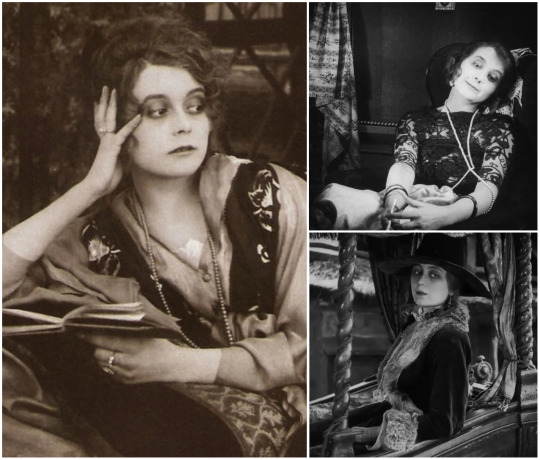
Herzlichen Glückwunsch zum Geburtstag, Gertrude Welcker! ❤️
(July 16, 1896 – August 1, 1988)
Gertrude Welcker was a stage and silent film actress; her film career was short lived, lasting from 1917 to 1925. The role she’s best known as, the alluring and enigmatic Countess Dusy Told of Fritz Lang’s 1922 epic crime thriller masterpiece, Dr. Mabuse, the Gambler.
Below is a summary of her life and career, with the people she had collaborated with as an actress.
She was born in Dresden, Saxony, Germany on July 16, 1896. Her younger brother Herbert was born in 1898. Gertrude’s father worked as editor-in-chief and general manager of the Posener Tageblatt, he died in 1909.
During the First World War, she visited Max Reinhardt’s acting school in Berlin. In 1915-16, she had starred in productions at the Albert Theatre in her hometown. During the years of 1916-19, Welcker performed at Deutsches, Kammerspiele, and Volksbühne theatres. Her stage roles include portraying a prostitute in August Strindberg’s Meister Olaf, Lesbia in Friedrich Hebbel's Gyges and His Ring, Recha in Gotthold Ephraim Lessing’s Nathan the Wise, Sister Martha in Gerhart Hauptmann's The Ascension of Little Hannele, and Desdemona and Jessica in William Shakespeare’s Othello and Merchant of Venice respectively.
Her film debut in 1917 was in Felix Basch’s Eine Nacht in der Stahlkammer as Jane Kendall, starring Harry Liedtke as her husband. Her next film was as an angel in Hans Trutz in the Land of Plenty, starring and directed by her stage collaborator Paul Wegener. The film also featured film director Ernst Lubitsch who portrayed Satan.
In 1918, she was in Lupu Pick’s Der Weltspielgel with Bernd Aldor and Reinhold Schünzel. She also starred in Viggo Larsen's The Adventure of a Ball Night with Paul Bildt and Paul Biensfeldt.
Welcker was also in Carl Froelich’s Der Tänzer with Walter Janssen.
She was the lead in the low-budget films, Die Geisha und der Samurai in 1919 and Eine Frau mit Vergangenheit in 1920.
Gertrude Welcker acted in films alongside Conrad Veidt, but those films are sadly considered lost. They portrayed siblings in F.W. Murnau’s Evening – Night – Morning and in Carl Boese’s Nocturne of Love, with Veidt as Frederic Chopin. (I, for one, would’ve loved for her to have been in a film as one of his leading ladies!)
In Hans Werckmeister’s 1920 sci-fi film, Algol: Tragedy of Power, she portrayed Leonore Nissen opposite Emil Jannings. It also starred Hanna Ralph, Hans Adalbert Schlettow (whom Welcker would appear with in Part II of Dr. Mabuse), and John Gottowt. The sets of the film were designed by The Cabinet of Dr. Caligari’s Walter Reimann.
She also appeared in Richard Oswald’s Lady Hamilton in 1921 as Arabella Kelly, in her first scene she is seen with Theodor Loos.
In 1922, Welcker portrayed her most infamous role as Countess Told in Dr. Mabuse, the Gambler starring Rudolf Klein-Rogge, with Aud Egede-Nissen, Alfred Abel, and Bernhard Goetzke. Also, in that same year - Welcker was in Carl Froelich’s Luise Millerin, an adaptation of Friedrich Schiller's Intrigue and Love as Lady Emilie Milford, another of her noteworthy roles. Previously, she was in a stage production portraying the role of Lady Milford's maid, Sophie. The film's all-star cast featured Lil Dagover as the title character, Paul Hartmann, Walter Janssen, Friedrich Kühne, Fritz Kortner, Werner Krauss, and Reinhold Schünzel.
She portrayed the villainess Gesine von Orlamünde of Arthur von Gerlach’s 1925 period drama film, Chronicles of the Grey House. It stars Lil Dagover, Paul Hartmann, Rudolf Forster, and Rudolf Rittner. Thea von Harbou was the film’s screenwriter with music composed by Gottfried Huppertz.
Her final film role was in Goetz von Berlichingen of the Iron Hand as Adelheid von Walldorf. She continued to act on stage until 1930. She has a total of 64 film credits to her name.
Around July 1930, Welcker married the Swedish painter Otto Gustaf Carlsund. She met him while on a trip to Paris. Their marriage lasted until August of 1937 and had no children. Before WWII broke out, she worked as an editor for UFA and by 1941, was active for the Red Cross. Some time before the war's end, she managed to leave for Sweden, and lived the rest of her life there.
It’s a great loss that so many of the films Gertrude Welcker did are considered lost and that her career as a film actress was as short as it was. Certainly, that many of those lost films showcased her great versatility. Gertude Welcker carried a remarkable set of talent, grace, beauty, charisma, and wit and is one of my most favorite actresses of the silent era I love.
Her filmography can be viewed here and here.
#gertrude welcker#1910s#1920s#german actresses#silent era#silent film stars#birthday remembrance#botd#vintage#she's a great actress#and I absolutely ADORE her <333#I was captivated by her ever since I first watched Dr. Mabuse#dr. mabuse the gambler#countess dusy told#happy birthday!#my post
2 notes
·
View notes
Note
I hope you're answering questions and this one doesn't bother you. I'm curious about Tin/Jupiter and the roles it may have in an alchemical story.
I'm away from my reference books for a while, but off the top of my head the one character who is associated with Jupiter/tin is Ron Weasley in Harry Potter. Ron refers to Jupiter a few times in the series--he exclaims "By Jupiter" for example, if I recall correctly.
I know @hamliet has a copy of Lyndy Abraham's dictionary, so you might want to ask her to look up Jupiter/tin.
One of the plates in Splendor Solis is devoted to Jupiter, so that's a potential source of story ideas for an author who wants to work the "lesser" metals in. I'm unable to upload the image, but here's a description of it by Jorg Vonagel, an art historian at the State Museums of Berlin.
Drawn by two peacocks, their tail feathers down, Jupiter’s planetary chariot navigates its way across the heavens. Holding two arrows as attributes in his right hand, the planetary god sits enthroned in his chariot while an aid, kneeling before him, offers him a bowl. The more noble circles of society fall under Jupiter’s rule, including the nobility and the clergy. The painter of the Splendor Solis expands this group to include alchemists, whom he depicts in the right midground in a state of industrious activity. Here, one of the adepts can be seen leaning over towards a helmet-shaped oven-top known as an alembic, while the other one inspects the flask he is holding in his left hand. The left-hand side of the picture is occupied by a pigeon-blue palace building which is based on an engraving by Daniel Hopfer. Out the front of the building a pope seated beneath a red baldachin is crowning a new emperor. As is the case with several of the illustrations in the Splendor Solis, the coronation scene incorporates a number of details drawn from a woodcut in Hans Holbein the Younger’s series Bilder des Todes (Pictures of Death). Showing the emperor kissing the feet of the pope, Holbein’s woodcut “Der Bapst” (The Pope) signals the submissiveness of the secular world in the face of the church’s omnipotence. In the Splendor Solis, however, the emperor not only receives the crown with his head upright but is also endowed with the physiognomy of Charles v, who had just been crowned Holy Roman emperor in Bologna in 1530. This discovery is quite remarkable in an artistic sense insofar as the painter of the Splendor Solis took the liberty of updating the stereotypical pope and emperor featured in the original source of 1524-26 in order to capture the latest historical developments. Set within the angular niche of the inserted panel is a glass flask upon a green laurel wreath. Inside the flask, three birds – black, white and red – are fighting with one another. This renewed allusion to the three principal colours of alchemy is discussed in the text that precedes it. The painter copied the motif of the three fighting birds from the alchemical illuminated manuscript of the Aurora Consurgens. It symbolises the separation of matter by heating, its subsequent purification in the next stage of transmutation, and, as will be seen in the following miniature, its fusion into one bird with three heads.
6 notes
·
View notes
Text
Artist who explore the concept of “The Stranger”
Eric Fischl (1948- Present)
Eric Fischl is an American artist specialising in painting and sculpture. He received a B.F.A (Bachelor of Fine Arts) from the California institute of the Arts and went on to teach painting at the Nova Scotia College of Art and Design Where he met his wife April Gornik who is also a painter. Fischl draws inspiration from his upbringing of county club culture and exploring the relationship between lived experiences and cannot be mentioned. During his first solo exhibition he gained attention for depicting the dark side of ordinary American life.




Tacita Dean (1965-present)
Tacita Dean is a British artist based in Berlin Germany and Los Angeles California. Her work is mainly focused on conceptual film and photography as well as analog drawing exploring the concept of place and time. Dean graduated from Falmouth University 1988 and went on to gain an MA from
the Slate School of Fine Art in 1992. She has stated she is inspired my many writers and artists like Marcel Broodthaers and Robert Smithson among others. Tacita Dean’s work is interested in memories and how they relate to loss and time. She uses 16mm and 35mm film to capture a variety of complex narratives and themes. In her early work she used chalk on blackboard depicting ghost like ships and sea landscapes. She progressed to film and 2011 was asked to fill the turbine hall in Tate Modern using 35mm film and edited herself. She celebrated this film medium as signified its loss to to digital world. Named “Film” was shown on an 11 metre screen
She was also responsible for set design and costumes with the Royal ballet.
Her exhibition in 2023 in Paris displayed photograph taken in Japan in 2022. She aimed to show the seasons in Japan.



This shows a large photograph of a Japanese cherry blossom tree. Taken in Japan at a historic site in 2022. The trees there are 250 years old
“Sakura Study”(2022) a photograph print with white pencil.
Small Sakura Study (2022). There fragility is demonstrated by the use of supports made of wood.
“The Wreck of Hope” (2022)
Large scale chalk on blackboard

She uses this thick non fixed medium to demonstrate the fragility of our planet due to climate.
Film stills from “Paradise”(2021) this 35mm film with vibrant colour.

She was inspired from working with a choreographer from a ballet “ The Dante project” which she designed the set and costumes for.
0 notes
Text
Even though I've poked a hole in my own cup, one thing that keeps filling it up is: there's an artist whose work I've loved for years, she works internationally, she's an incredible sketch artist, painter and writer, she's a published author and produces so much creative work so regularly that it's overwhelming -- actually she's also a musician with music out, too. I bought two prints from her years ago, anyway, a few weeks ago she posted that an arrangement to rent out her Berlin apartment had fallen through. A friend of mine had just moved to Berlin and as far as I knew, was still looking for a more fixed-term place -- I sent him the post, and days later he was sending me videos from his new apartment: her sublet, filled with her oil paintings and drawings. This makes me so incredibly happy, I feel like I'm living vicariously through him whenever he shares photographs of the place. What the heckin' heck, man! Weird world. I know it's not that dramatic of a deal to most, but she is a seriously great artist and he is a wonderful person so I'm just !!!!!!!!!! it's awesome. A positive impact on two people's lives!!!!!!!!! Yay!!!! I feel less bad!!!!!!!
0 notes